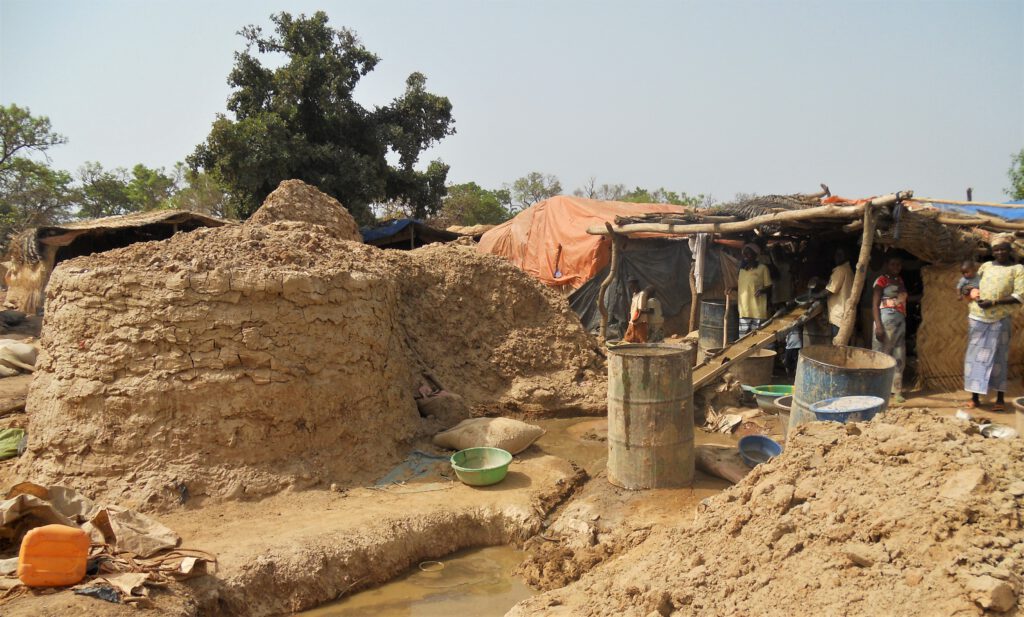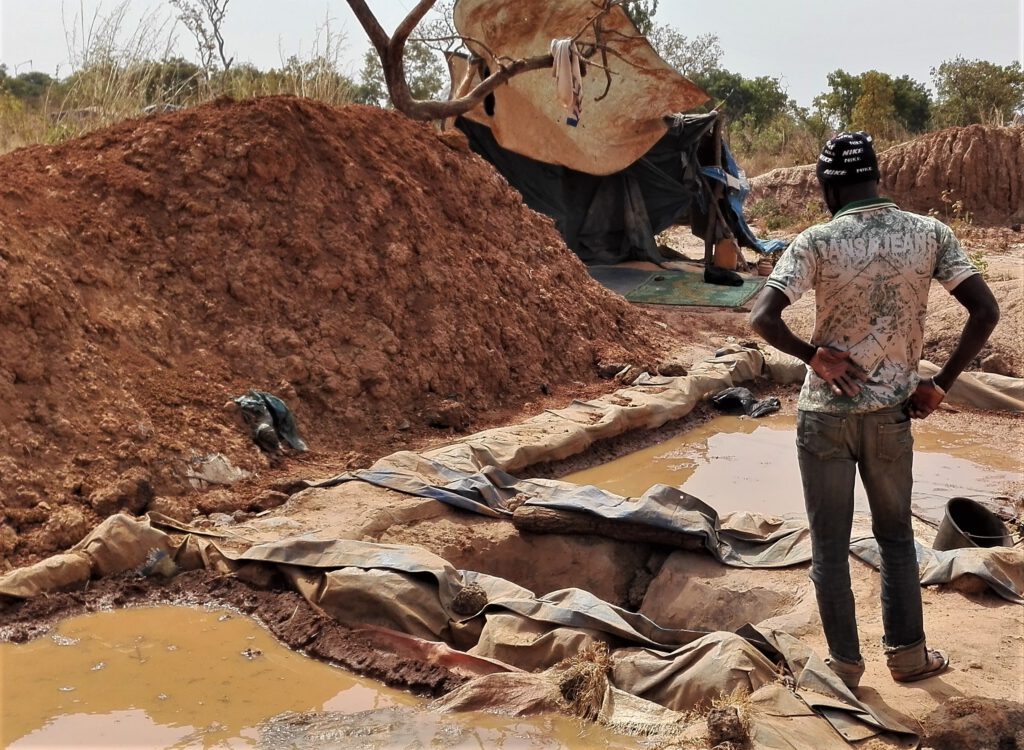Technological innovation in ASGM does not only occur through voluntarist interventions aimed at promoting cleaner production, but also as a consequence of transformations in the political economy of resource extraction. In Burkina Faso, the diffusion of cyanide has determined a shift away from mercury-based processing techniques and reshaped the organization of production in artisanal mining sites.
Cristiano Lanzano, Luigi Arnaldi di Balme
When the sustainability of artisanal and small-scale gold mining (ASGM) is discussed, concern over the use of toxic chemical products is often brought to the fore. For example, treaties such as the Minamata convention on mercury, programs elaborated by international organizations or NGOs, and actions from national governments try to tackle the widespread use of mercury in processing gold ore. The impact and success of these initiatives vary. Many have observed that, in order to be effective, strategies to reduce the use of harmful chemical products must be based on thorough consideration of the socio-economic determinants and implications of specific technological choices.
At the same time, ASGM should be understood as a dynamic sector, where sociotechnical innovation – in whatever direction – takes place not only through top-down or voluntarist interventions, but also as a consequence of the high degree of human mobility and circulation of technical knowledge, and of the transformations in the political economy of resource extraction occurring at different scales.
Conflicts around the ownership of leftovers
In our recently published article, “Who owns the mud? Valuable leftovers, sociotechnical innovation and changing relations of production in artisanal gold mining (Burkina Faso)”, we analyze the case of Burkina Faso, where the use of cyanide to process gold ore in ASGM sites started to grow significantly in the early 2010s. While it did not entirely replace the use of mercury, the increased resort to cyanide-based processing transformed the existing mechanisms of value creation along the gold production chain, and reshaped the organization of work and the relations between different economic actors (miners, informal entrepreneurs active in processing, permit holders).
This change was not always seamless and peaceful. In 2013, for example, the Burkinabe press reported a conflict in the mining site of Nicéo, opposing, on one side, the representative of a local private company holding an artisanal mining permit on the area, and, on the other side, a group of women (see also here) who specialized in “washing” (processing with water on sluice boxes) the pulverized ore, before later reaggregation through mercury.

Similarly to other conflicts occurring in several regions around the same years and often leading to court cases, this controversy revolved around the ownership of leftovers and residual by-products such as the piles of “mud” (locally called garga) accumulating at the end of the washing stalls. In a system dominated by mercury-based processing and where access to cyanidation techniques was restricted, these residues used to have little immediate value and functioned as an in-kind remuneration for women entrepreneurs active in washing, who would reprocess them or sell them to external traders. In the years after 2012-3, cyanide started to become more accessible and many ASGM sites became equipped with basic cyanidation facilities, where important quantities of gold could still be extracted from the residual garga. The opportunities created by this “new” technology spurred conflict: by-products that were previously considered residual, and that used to be allocated through flexible informal arrangements, were now highly desirable and became the object of claims of exclusive property rights.
Competition and saturation of the mining space
How did this dramatic change happen, and why did it happen at that particular time? Globally, cyanide was known as an effective product to process gold ore since its introduction in the industrial mining sector at the end of the 19th century. Many decades later, it was probably the regular interactions between technicians at large-scale companies and investors in the small-scale sector that facilitated the use of cyanide by artisanal miners, which started to be observed after the 1980s in countries like the Philippines or Indonesia (see different chapters in this edited volume).
In Burkina Faso, too, cyanidation facilities were known to exist prior to the 2010s: however, their number was very limited and their access was restricted, controlled in many cases by local private companies (the comptoirs) which had obtained formal ASGM permits and invested in this technology. During our initial fieldwork in different artisanal mining sites, people would sometimes discreetly refer to “some areas out there” where cyanide was used. But the main emphasis was on mercury-based processing techniques that required the fine crushing of ore extracted from the mining shafts, its “washing” on sluice boxes, and its final processing with drops of mercury to aggregate little spheres of doré.
In the years around 2012, however, competition on the available space for mining had become very intense. Also due to the legislative and economic reforms of the previous decade, transnational companies had increasingly invested in the country and started to open large-scale mines. At the same time, local entrepreneurs active in the small-scale sector intensified their attempts to obtain official ASGM permits – which by 2013, as shown by several EITI (Extractive Industries Transparency Initiative) reports, covered most of the known gold reserves – and began to put this “institutional investment” to profit, starting to claim exclusive rights over certain by-products that were previously more accessible or allocated more informally. Cyanidation was the most obvious method to maximize gains in a particularly competitive context.
From an economy of leftovers to the center of the value chain
Initially, many court cases generated by these claims were ruled in favor of the private comptoirs, given that the women active in processing, and other operators working informally in ASGM sites, had no formal base to defend their rights. Yet, many artisanal miners reacted by moving out of the areas controlled by the private companies and relocating their activities in new sites where no permit was released or enforced. After 2013, the stagnation in global gold prices, the first signs of depletion in many mining areas, and probably also the political change that deprived some companies of their influential support, contributed to the crisis of the private comptoirs, which repositioned mostly as final buyers and loosened their territorial control on production. The centrality of cyanide-based techniques was now evident, with basic cyanidation facilities being set up in most ASGM sites and easily accessible for most miners.

This development reshaped significantly the organization of work and production in ASGM sites. Informal committees constituted by representatives of migrant miners, local residents and customary authorities occupied the vacuum left by the private companies. In many cases, investors and miners sought to “integrate” the whole chain from extraction to final sale in their individual enterprises, in order to retain control of all residues and minimize loss.
The diffusion of cyanide transformed an “economy of leftovers” into the main segment of value creation, creating conflict and shifting power. While it generated obvious challenges concerning the management and mitigation of its environmental impact, it also questioned established positions and created new opportunities in the ASGM economy. Ultimately, it determined a (partial) shift away from the use of mercury, although maybe not in the direction wished by more institutional attempts to transform ASGM processing techniques.
Cristiano Lanzano is Senior Researcher at the Nordic Africa Institute in Uppsala, Sweden.
cristiano.lanzano@nai.uu.se
Twitter: @stiannu
Luigi Arnaldi di Balme is Research Associate at IFSRA in Ouagadougou, Burkina Faso.
luigi.arnaldi@insuco.com
Gold Matters: Sustainability Transformations in Artisanal and Small-scale Gold Mining: A Multi-Actor and Trans-Regional Perspective is a transdisciplinary research project which aims to consider whether and how a transformative approach towards sustainability can arise in Artisanal and Small-scale Gold Mining (ASGM). For more information see www.gold-matters.org.
Cite as follows: Lanzano, C. and Arnaldi di Balme, L. (2021), Beyond mercury? ASGM and the shift to cyanide in Burkina Faso, http://gold-matters.org/?p=1455
